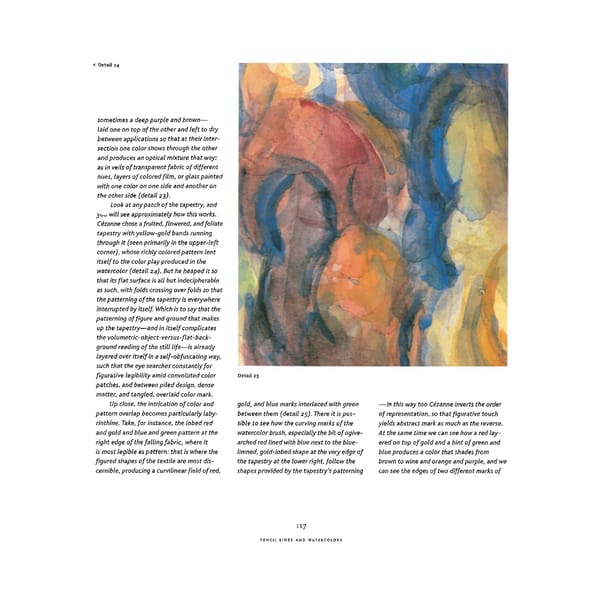< Detail 24 sometimes a deep purple and brown— laid one on top of the other and left to dry between applications so that at their inter- section one color shows through the other and produces an optical mixture that way: as in veils of transparent fabric of different hues, layers of colored film, or glass painted with one color on one side and another on the other side (detail 23). Look at any patch of the tapestry, and you wilisee approximately how this works. Cezanne chose a fruited, flowered, and foliate tapestry with yellow-gold bands running through it (seen primarily in the upper-left corner), whose richly colored pattern lent itself to the color play produced in the watercolor (detail 24). But he heaped it so that its flat surface is all but indecipherable as such, with folds crossing over folds so that the patterning of the tapestry is everywhere interrupted by itself. Which is to say that the patterning of figure and ground that makes up the tapestry—and in itself complicates the volumetric-object-versus-flat-back- ground reading of the still life—is already layered over itself in a self-obfuscating way, such that the eye searches constantly for figurative legibility amid convoluted color Detail 25 patches, and between piled design, dense matter, and tangled, overlaid color mark. Up close, the intrication of color and gold, and blue marks interlaced with green •—in this way too Cezanne inverts the order pattern overlap becomes particularly laby- between them (detail 25). There it is pos- of representation, so that figurative touch rinthine. Take, for instance, the lobed red sible to see how the curving marks of the yields abstract mark as much as the reverse. and gold and blue and green pattern at the watercolor brush, especially the bit of ogive- At the same time we can see how a red lay- right edge of the falling fabric, where it arched red lined with blue next to the blue- ered on top of gold and a hint of green and is most legible as pattern: that is where the limned, gold-lobed shape at the very edge of blue produces a color that shades from figured shapes of the textile are most dis- the tapestry at the lower right, follow the brown to wine and orange and purple, and we cernible, producing a curvilinear field of red, shapes provided by the tapestry's patterning can see the edges of two different marks of 117 PENCIL LINES AND WATERCOLORS
 Cézanne in the Studio: Still Life in Watercolors Page 131 Page 133
Cézanne in the Studio: Still Life in Watercolors Page 131 Page 133